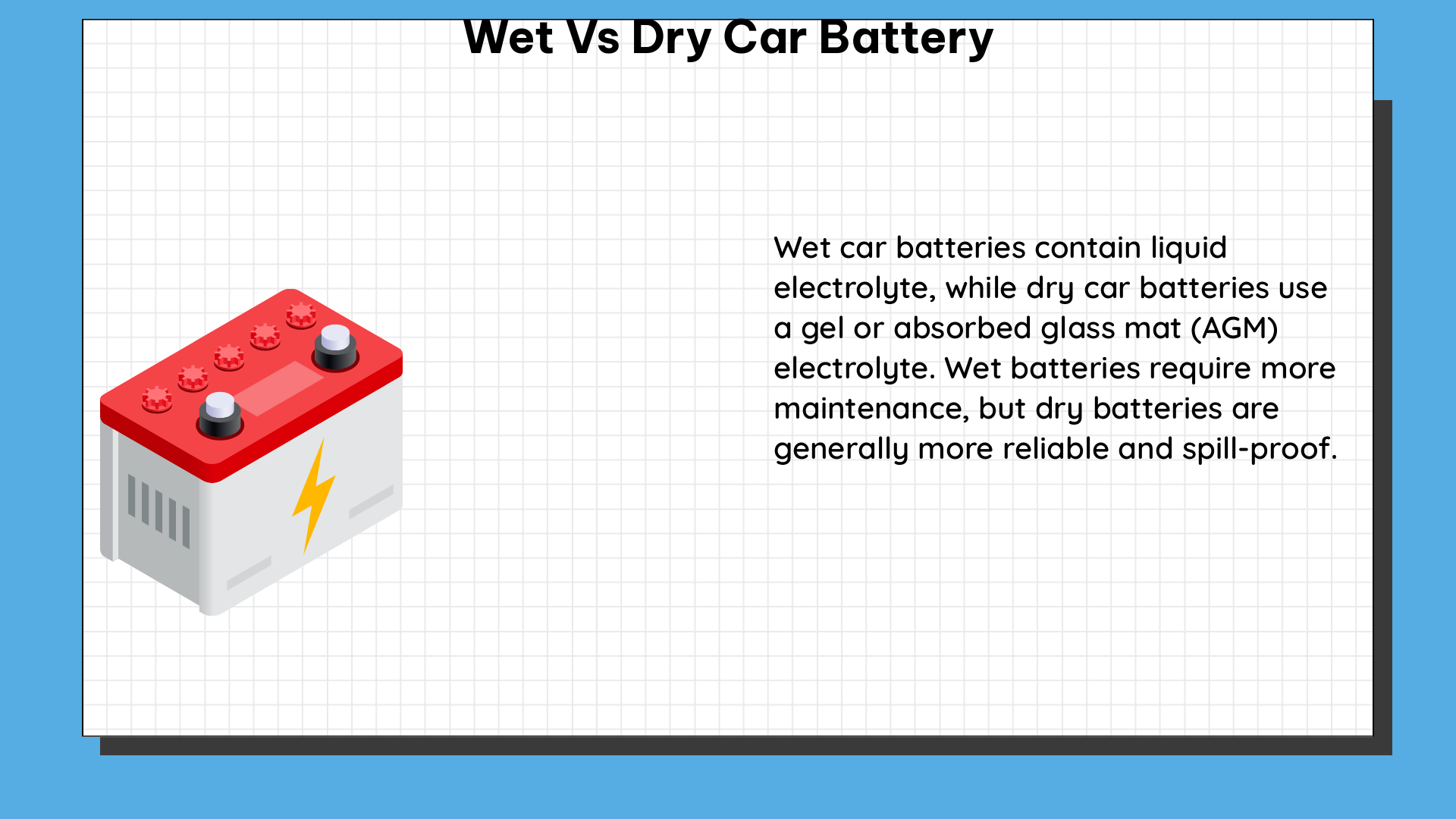Wet and dry car batteries are two distinct types of lead-acid batteries that differ in their electrolyte composition and maintenance requirements. Understanding the key differences between these two battery types can help you make an informed decision when it comes to selecting the right battery for your vehicle.
Wet Car Batteries
Wet car batteries, also known as flooded batteries, contain a liquid electrolyte composed of sulfuric acid and water. This type of battery requires regular maintenance, including checking and refilling the electrolyte level with distilled water. Wet car batteries have a longer lifespan compared to dry car batteries, typically around 4-5 years, and provide a higher cold cranking amps (CCA) rating, making them ideal for starting engines in cold climates. However, they are more prone to leakage and corrosion due to the liquid electrolyte.
Technical Specifications
- Specific gravity range: 1.265-1.300
- Charging voltage: 14.4-14.8V
- Self-discharge rate: Higher compared to dry car batteries
Advantages
- Longer lifespan (4-5 years)
- Higher CCA rating, suitable for cold climates
- Lower cost compared to dry car batteries
Disadvantages
- Require regular maintenance (checking and refilling electrolyte level)
- More prone to leakage and corrosion due to liquid electrolyte
- Heavier and bulkier compared to dry car batteries
Dry Car Batteries

Dry car batteries, also known as maintenance-free batteries or sealed batteries, contain a gel or absorbed glass mat (AGM) electrolyte that is immobilized, preventing leakage and reducing maintenance requirements. Dry car batteries have a shorter lifespan compared to wet car batteries, typically around 2-3 years, and provide a lower CCA rating. However, they are more resistant to vibration and can be mounted in various orientations.
Technical Specifications
- Specific gravity range: 1.270-1.330
- Charging voltage: 14.2-14.4V
- Self-discharge rate: Lower compared to wet car batteries
Advantages
- Reduced maintenance requirements (no need to check or refill electrolyte)
- More resistant to vibration and can be mounted in various orientations
- Lighter and more compact compared to wet car batteries
Disadvantages
- Shorter lifespan (2-3 years)
- Lower CCA rating, less suitable for cold climates
- Higher cost compared to wet car batteries
DIY Tips
Wet Car Batteries
- Ensure the electrolyte level is at the recommended level and avoid overfilling.
- Regularly check the battery terminals for corrosion and clean them if necessary.
- Avoid exposing the battery to extreme temperatures, as this can affect its performance and lifespan.
Dry Car Batteries
- Ensure the battery is securely mounted and avoid exposing it to extreme temperatures.
- Regularly check the battery terminals for corrosion and clean them if necessary.
- Avoid overcharging the battery, as this can lead to premature failure.
Conclusion
In summary, wet car batteries and dry car batteries have their own unique characteristics and are suitable for different applications. Wet car batteries offer a longer lifespan and higher CCA rating, making them a good choice for vehicles that need to start in cold climates. Dry car batteries, on the other hand, require less maintenance and are more resistant to vibration, making them a convenient option for some users. When choosing a car battery, it’s important to consider your specific needs and the operating conditions of your vehicle.
References
- Wet Charged MF vs Dry Charged Car Battery: Which Do You Need?
- Dry Cell vs Wet Cell Batteries
- Acid Stratification and Surface Charge
- Dry Cell vs Wet Cell Batteries FAQ
- Dry Battery

The lambdageeks.com Core SME Team is a group of experienced subject matter experts from diverse scientific and technical fields including Physics, Chemistry, Technology,Electronics & Electrical Engineering, Automotive, Mechanical Engineering. Our team collaborates to create high-quality, well-researched articles on a wide range of science and technology topics for the lambdageeks.com website.
All Our Senior SME are having more than 7 Years of experience in the respective fields . They are either Working Industry Professionals or assocaited With different Universities. Refer Our Authors Page to get to know About our Core SMEs.